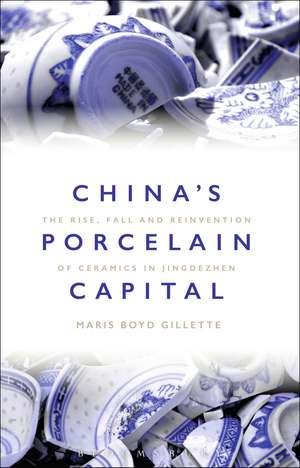China's Porcelain Capital: The Rise, Fall and Reinvention of Ceramics in Jingdezhen
Autor Dr Maris Boyd Gilletteen Limba Engleză Paperback – 24 ian 2018
Preț: 197.34 lei
Preț vechi: 229.86 lei
-14% Nou
Puncte Express: 296
Preț estimativ în valută:
37.76€ • 39.42$ • 31.25£
37.76€ • 39.42$ • 31.25£
Carte tipărită la comandă
Livrare economică 04-18 aprilie
Livrare express 28 februarie-06 martie pentru 56.48 lei
Preluare comenzi: 021 569.72.76
Specificații
ISBN-13: 9781350044821
ISBN-10: 1350044822
Pagini: 200
Dimensiuni: 155 x 234 x 17 mm
Greutate: 0.32 kg
Ediția:NIP
Editura: Bloomsbury Publishing
Colecția Bloomsbury Academic
Locul publicării:London, United Kingdom
ISBN-10: 1350044822
Pagini: 200
Dimensiuni: 155 x 234 x 17 mm
Greutate: 0.32 kg
Ediția:NIP
Editura: Bloomsbury Publishing
Colecția Bloomsbury Academic
Locul publicării:London, United Kingdom
Caracteristici
Author draws on ethnographic research conducted in Jingdezhen and historical archival sources
Notă biografică
Maris Boyd Gillette is E. Desmond Lee Professor of Museum Studies and Community History, University of Missouri, St Louis, USA. She is the author of Between Mecca and Beijing: Modernization and Consumption Among Urban Chinese Muslims (2000).
Cuprins
1. The world's most famous ceramics and the people who made them2. Creating a porcelain capital, prehistory to 17853. Decline and disarray, 1786 - 19484. Production and politics, 1949 - 19725. Dual track porcelain, 1973 - 19936. Porcelain capital no more, 1994 - 20107. From porcelain capital to heritage siteGlossaryBibliographyIndex
Recenzii
[China's Porcelain Capital] is filled with intriguing facts. Those with an interest in porcelain and anyone thinking about working in China, or having artwork made in China, should consider reading this book.
Maris Boyd Gillette's book is a welcome addition to the literature on Jingdezhen. It is well sourced and benefits greatly from research in the town and familiarity at first hand with the practical aspects of the industry.
A comprehensive examination of the ways in which the government of China has controlled, invested in, taxied, managed and consumed the products of the Chinese porcelain industry, especially in the twentieth century.
Historians like to boast of getting their hands dirty in the archives. In this fascinating book, Maris Gillette got her feet muddy to tell the 1000-year story of how the Chinese state, global markets and the potters of Jingdezhen have interacted to produce the most extraordinary porcelains in the world.
Positioning ethnographic writing at the center of art historical and anthropological perspectives, Gillette makes an enormous contribution to our understanding of cultural production in China. This astute and intimate portrait uses first-rate scholarship and a unique apprenticeship in the community to reveal the complexities of contemporary ceramic production in Jingdezhen.
What a story, the town of Jingdezhen! It began making ceramics over a thousand years ago, produced porcelain for emperors of four dynasties while it made blue-and-white ware famous throughout the world, declined sadly under the Nationalist Republic, revived under Mao's state socialism, and was abruptly shut down in China's economic reforms of the 1990s, only to emerge for the third time as a destination for tourists and artists in the 21s century. Maris Gillette tells this story in a clear, fast-moving narrative, completely free of academic jargon, that will appeal to scholarly and popular readers alike.
A fascinating read providing an historic and contemporary context of a city in China, whose economic survival and worldwide fame has been uniquely due to a single product, porcelain. For me, involved in education and as an artist potter making work on a regular basis in 'Jingdezhen' it was both intriguing in its narrative and hugely informative.
Maris Boyd Gillette's book is a welcome addition to the literature on Jingdezhen. It is well sourced and benefits greatly from research in the town and familiarity at first hand with the practical aspects of the industry.
A comprehensive examination of the ways in which the government of China has controlled, invested in, taxied, managed and consumed the products of the Chinese porcelain industry, especially in the twentieth century.
Historians like to boast of getting their hands dirty in the archives. In this fascinating book, Maris Gillette got her feet muddy to tell the 1000-year story of how the Chinese state, global markets and the potters of Jingdezhen have interacted to produce the most extraordinary porcelains in the world.
Positioning ethnographic writing at the center of art historical and anthropological perspectives, Gillette makes an enormous contribution to our understanding of cultural production in China. This astute and intimate portrait uses first-rate scholarship and a unique apprenticeship in the community to reveal the complexities of contemporary ceramic production in Jingdezhen.
What a story, the town of Jingdezhen! It began making ceramics over a thousand years ago, produced porcelain for emperors of four dynasties while it made blue-and-white ware famous throughout the world, declined sadly under the Nationalist Republic, revived under Mao's state socialism, and was abruptly shut down in China's economic reforms of the 1990s, only to emerge for the third time as a destination for tourists and artists in the 21s century. Maris Gillette tells this story in a clear, fast-moving narrative, completely free of academic jargon, that will appeal to scholarly and popular readers alike.
A fascinating read providing an historic and contemporary context of a city in China, whose economic survival and worldwide fame has been uniquely due to a single product, porcelain. For me, involved in education and as an artist potter making work on a regular basis in 'Jingdezhen' it was both intriguing in its narrative and hugely informative.
